id 2242 neoclassicism and (intro to) romanticism
1/11
There's no tags or description
Looks like no tags are added yet.
Name | Mastery | Learn | Test | Matching | Spaced |
|---|
No study sessions yet.
12 Terms
neoclassicism and romanticism
neoclassicism:
- late 18th century - early 19th
- continues characteristics of moralizing art and rejects rococo
- didacticism, moral stories about being a good citizen of the new french republic
romanticism:
- 19th century
- literature; “the sublime” story-telling about tragedy
→tragic events: shipwrecks, murder, tragic heroes, martyrs, anti-heroes;; “irrational nature” “irrational consciousness: nightmares”
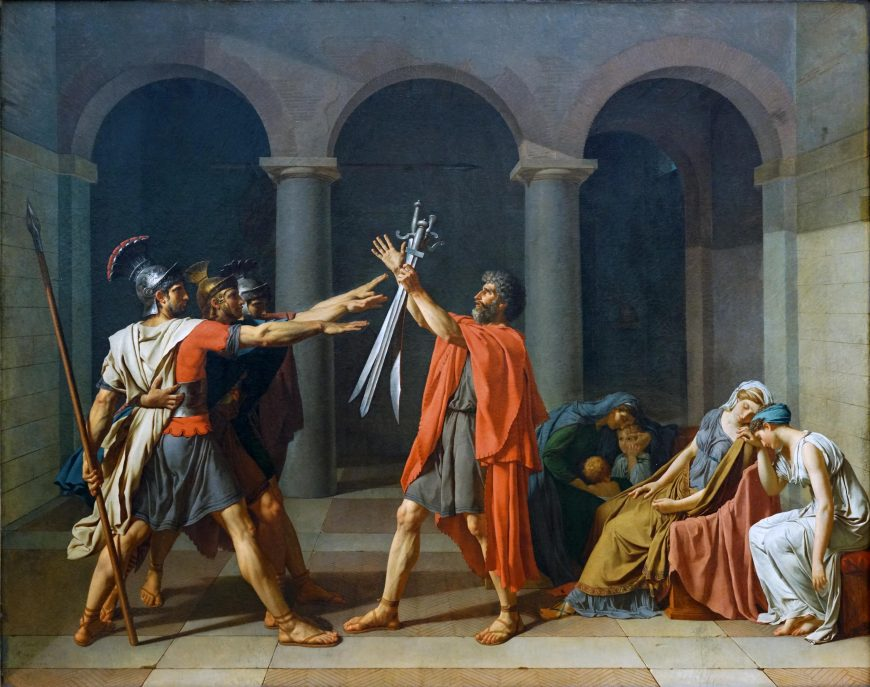
Jacques-Louis David, Oath of the Horatii, 1784
Neoclassicism
subject matter:
- Livy’s The History of Rome (1st c. BC): 3 members of the Roman Horatii family have been chosen for a duel against 3 from the Curiatii family to settle disputes b/w Romans & another city
content: Horace - father, Horatii - family
- story of “sacrifice” of the individual for the good of many
- used as propaganda for the french revolution
*one of the daughters (on right) is married to one of the enemy (she’ll either lose her husband or her brother)
melodramatic moment: horace in center; axial balance; 3 brothers paralleling in agreement (parallelism = unified)
→ (“Baroque subject matter”) *but w/ selection of story of heroism
- (“cult of hero”) *patriotic/political agenda
- hero = good citizen → french rev. propaganda
composition: all action in the foreground, stage-like setting, tenebroso
- life-size scale artwork → adds to the depth of the story
- architecture divides them: sons on left, father centered, daughters on right
- repetition of red/blue colors (drawing on patriotic colors → french flag)
The French Revolution
1789 - 1799: societal reform
overthrow of monarchy
establishment of a (democratic) republic
storming of the bastille, 1789
signing of the “rights of man,” 1791
reign of terror: more than 18k citizens executed by guillotine in 1793 to 1794
signing of the “rights of man & citizen”, 1791
1. men are born and remain free and equal in rights
2. preservation of the rights of man: liberty, property, security, and resistance to oppression
republican calendar
→ celebrated the revolution “as a return to natural time,” counted Year 1 from 1791 and remained until Year XIV (1806)
→ renaming months after the seasons—Brumaire, Germinal, Thermidor
→ weeks divided into ten day units called the decade
- days: Primodi, Duodi, Tridi, Quartidi w/ the 10th day, the Decadi, as the official day of rest
→ replacing holidays w/ names of flowers, veggies, and farming utensils: day of the pumpkin, day of the eggplant, etc
republican time:
→ each day in the calender was divided into 10 hours, each hour into 100 decimal minutes
→ an hour = 144 conventional min
→ a min = 86.4 conventional sec
→ a sec = 0.864 conventional sec
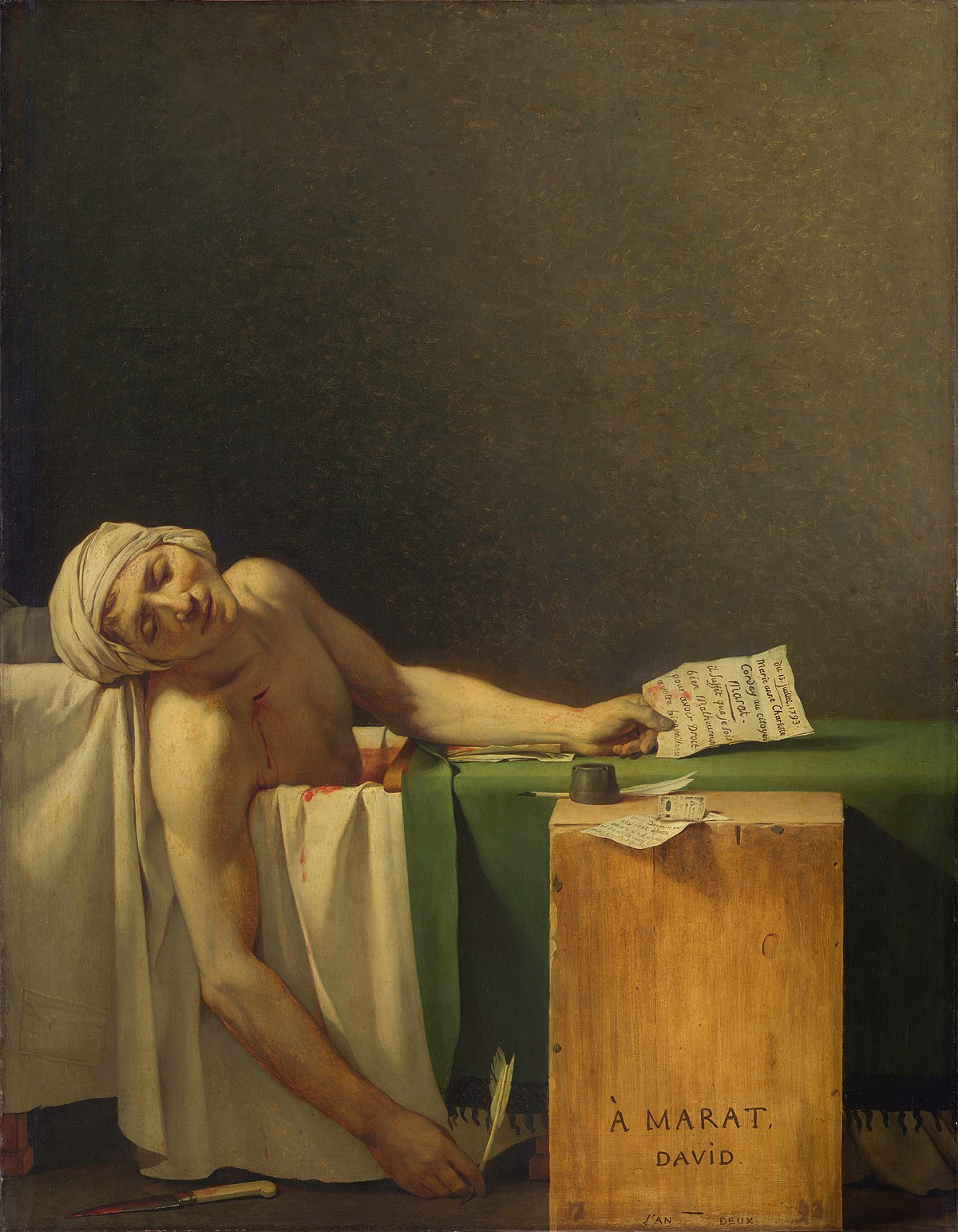
David, Death of Marat, 1763
Neoclassicism
“cult of the hero”
Jean-Paul Marat: best known as a radical journalist and politician from the french revolution
→ assassinated on July 1793 by Charlotte Corday, while he soaked in a bath as treatment for a skin condition
didactic: how to be a good citizen
death = peaceful
propaganda for french revolution
politician at work, simplicity of setting
“Baroque composition”: all action in foreground, stage-like setting, tenebroso
propaganda → “the pen is mightier than the sword”
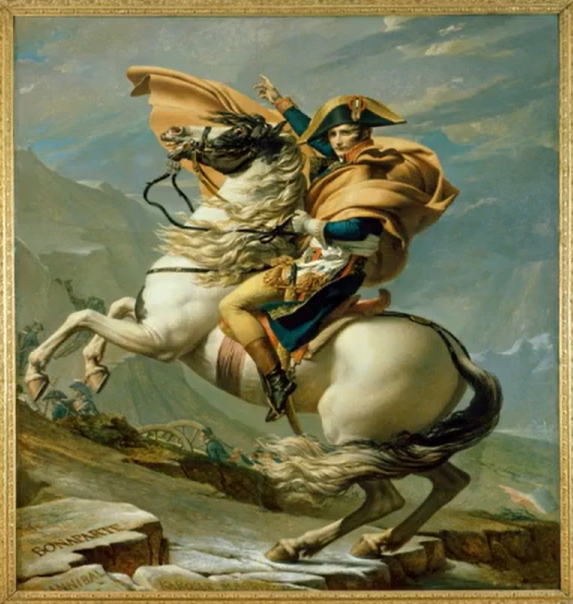
David, Napoleon Crossing the Alps, 1800
Neoclassicism
“cult of the hero”: engaged eye, control of animal
approx. 9ft tall and 7ft wide → life-size
Napoleon Bonaparte: (Corsica, 1769 - 1821)
- while a general, invaded Egypt
- 1799, seized power in France
- crowned himself emperor, 1804
1800: crosses Alps to Italy to reinforce French troops fighting against Austrian occupation
*signature in bottom right, also has leader before him → Hannibal, Charles the Great
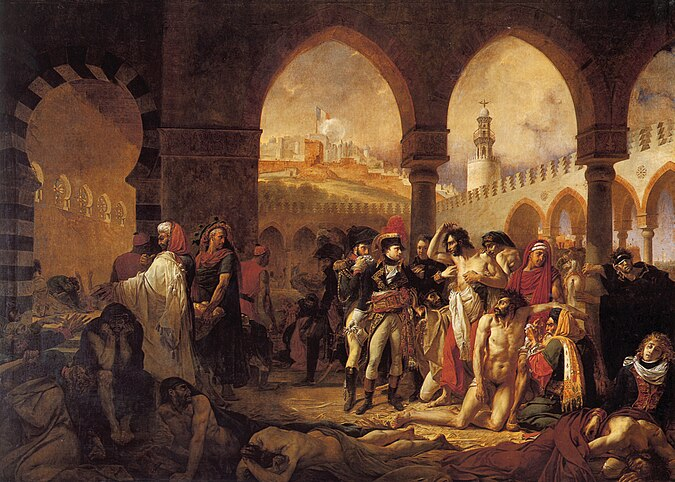
Antoine Jean Gros, Pest House at Jaffa, 1804
Neoclassicism
commissioned by Napoleon
+in 1799 during the campaigns in the middle east, while in Jaffa, Napoleon’s army fell victim to a plague epidemic
+Napoleon visited them in a hospital (called a Pest House: “pestilence”)
→ Napoleon in the hero here (cult of the hero → him touching the plague victim)
+life-size scale, setting → mosque, minaret
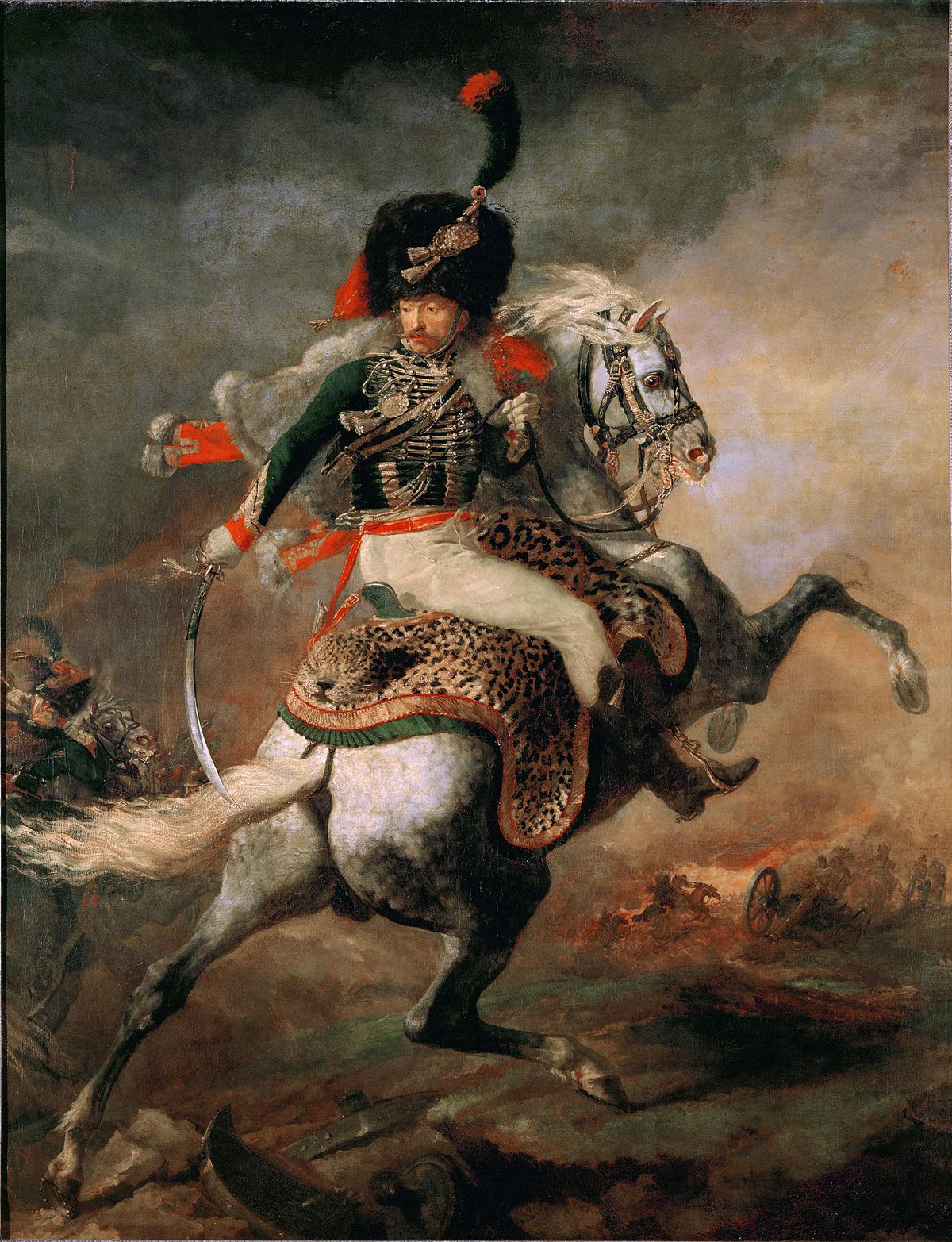
Theodore Gericault, The Mounted Officer of the Imperial Guard, 1812
Romanticism
~he’s a deserter → fleeing from battle
~anti-hero
~tragic story
romance literature: “the sublime”
introduced into french culture by Edmund Burke, “A Philosophical Inquiry into our idea of the sublime & the beautiful,” 1756":
educational reform, studied “how we learn” → “how a lesson is engraved in our being”
proposed that we have a sublime experience when we intensely learn something: awe inspiring, intense, emotional
~ tragic story, victim, fear, ugliness, “irrationality”
literature, art, drama: ways of having a “sublime" experience” as a surrogate and not a victim
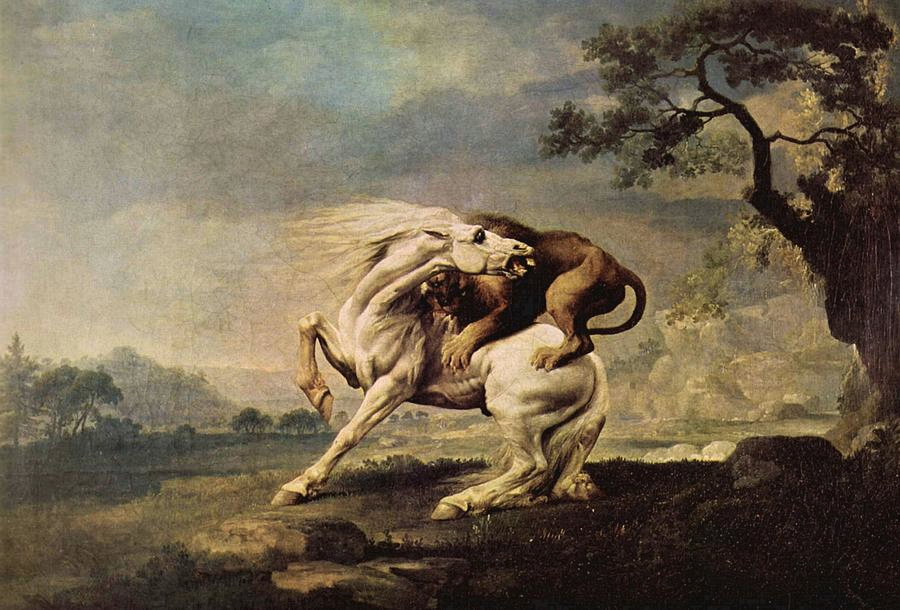
George Stubbs, Lion Attacking a Horse, 1763
Romanticism
content:
the sublime: tragedy, irrationality/power
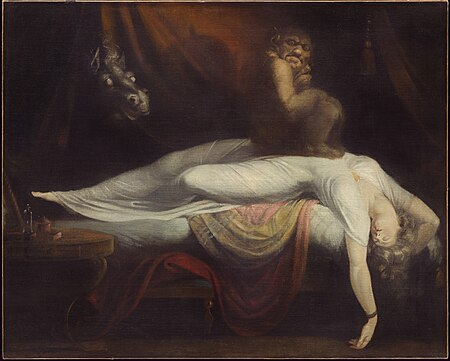
Henry Fuseli, The Nightmare, 1781
Romanticism
the sublime: an incubus, engaged eye
~incubus: male demon, lies to sleeping people
~female horse: Germanic folktales: ppl in bad dreams visited by horses/hags
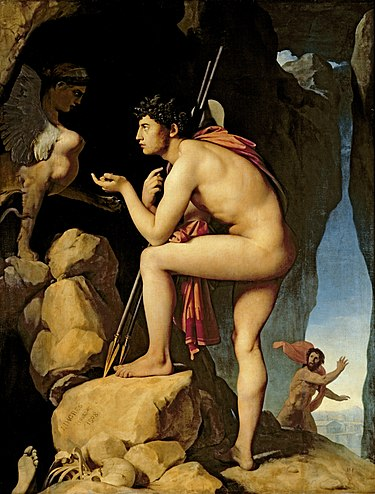
J.A.D Ingres, Oedipus and the Sphinx, 1801
Romanticism
“refers to a type of French novel”
~Roman a clef / roman a cle: “tragic twist in a plot”
Romantic literature - a story w/ tragic overtones
“the sublime” as subject matter
embodying answer to riddle: a human → as a child crawls on all fours, as an adult walks on 2 legs, in old age uses a stick as a 3rd leg
child→ abandoned: crawling on 4s
mature adult: Oedipus at cave
blinded man: walking w/ stick
planimetric separation:
used to tell episodes in story
foreground (sphinx, riddle), middle ground (witness), background (Thebes: where tragedy concludes)
implied lines
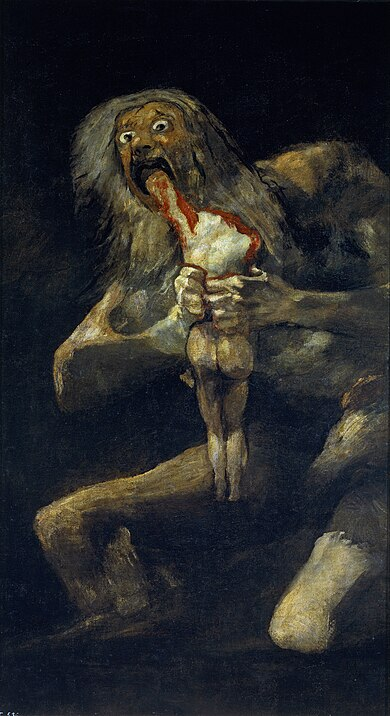
Goya, Saturn Devouring his Children, 1823
Romanticism
saturn/crones: roman god
prophesized that one day Saturn would lose power when one of his children would depose him
to prevent: he ate his kids
when 6th, Jupiter (eventually defeats Saturn), was born, the wife spirited him away to Crete island
tragic “sublime”
out of focus: “irrationality”
tenebroso
engaged eye: wild eyed
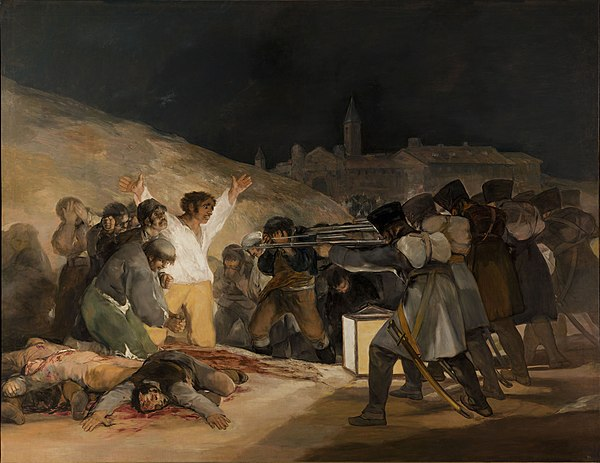
Goya, Third of May 1808, 1814
Romanticism
may 2nd 1808
spanish peasants rose up against mercenaries of Napoleon’s army occupying Madrid
may 3rd
revolutionaries were killed by firing squad by the French army
tenebroso
sublime
moment: tragic
~sequence: waiting to be killed, then you’re up, then outcome
~firing squad → united force
you don’t see the moment, you see the anxiety building up to the moment
viewer’s vantage point: parallel
~guy holding hands up: cross → crucifix of Christ